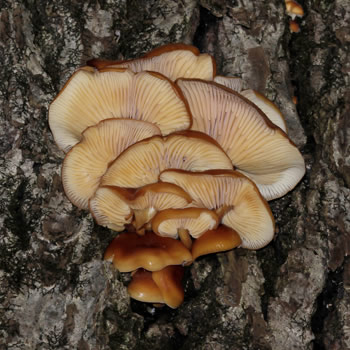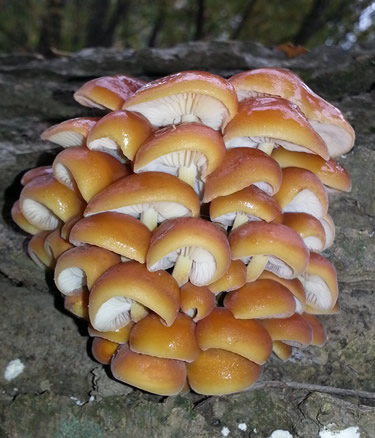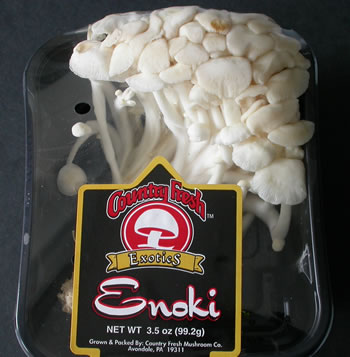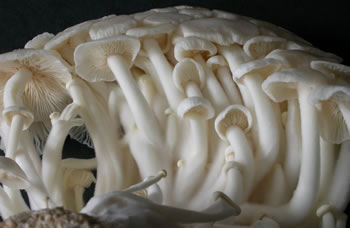Flammulina velutipes
Scientific name: Flammulina velutipes (Curtis) Singer
Derivation of name: Flammulina means "very small
flame."
Velut- means "velvet" or "velvety"
and refers to
the velvety stipe.
Synonyms: Agaricus velutipes Curtis; Collybia velutipes
(Curtis) P. Kumm.
Common name(s): Velvet foot; Winter mushroom.
Phylum: Basidiomycota
Order: Agaricales
Family: Physalacriaceae
Occurrence on wood substrate: Saprobic; fruiting in
clusters on deciduous trees, logs, and stumps; October
through May, winter during winter thaws, summer cold
spells.
Dimensions: Caps 2.5-5 cm wide; stipes 2.5-7.5 cm long
and 3-5 mm thick.
Cap: Slimy to tacky; smooth; reddish-brown to tawny,
darker in the center.
Gills: Attached; whitish to yellowish.
Spore print: White.
Stipe: Yellowish at the top, becoming darker toward the
base due to dense, velvet-brown pubescence.
Veil: Absent.
Comments: This mushroom is cultivated in the Orient as
Enotake or Enoki-take. The commercial product is
strikingly
different than the form found in the wild.
More information at MushroomExpert.com:
More information at TomVolkFungi.net:

Figure 1. A cluster of Flammulina velutipes on wood.
Even in this photograph the
caps look sticky. Note the
dark velvety lower stipes.
Photo © Pam Kaminski.

Figure 2. Compared to the specimens in Figure 1, the
caps of this cluster are much lighter in color.
Photo © William Roody.

Figure 3. The gills of Flammulina velutipes are whitish
to yellowish. Photo © Al Simpson.

Figure 4. A tight cluster of young specimens of Flammulina
velutipes. The glistening caps
are slimy or tacky.
Photo © George Morrison.

Figure 5.
This is the same cluster of specimens as in
Figure 4. The young gills are quite white and the stipes have
not yet
developed the characteristic velvety-brown
pubescence of the species. Photo © George Morrison.

Figure 6. Enotake or Enoki-take.
Photo © Gary Emberger.

Figure 7. Enoki package of Figure 4 opened.
I bet
you're wondering
why the cultivated form looks so
different. The answer is
available at Tom Volk's web
site. Photo © Gary Emberger.

Figure 8. Commercial Enoki caps and gills.
Photo © Gary Emberger.

Figure 9. The pale, elongated Enoki-like specimens of
Flammulina velutipes in the
bottom half of the
photograph were revealed when the
bark they were
growing under was removed. Photo © Cecily Franklin.